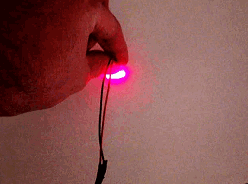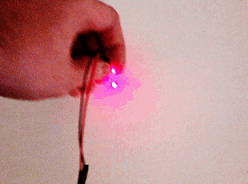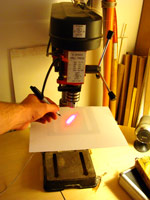You want DIFFUSED diodes with Laser Therapy for Hair Loss—not dots! So how much do ‘diffused diodes’... diffuse?? -Laser diffusion sizes at 1cm / 2cm / 3cm!
.jpg)
Guess which type mass-marketed crap uses? :P
We noticed eons ago from our own experiments that "diffused" (uncollimated)laser diodes (with lens caps removed) work better than "dots". We also noticed that most pro devices remove the lens caps and have "diffused" diodes, whereas many of the mass-marketed crappy ones still have that lens cap, constraining the footprint and sucking away power.
This will help you if you want to see the rough size of a diffused diode at the heights of 1cm, 2cm, and 3cm...
This will help you if you want to see the rough size of a diffused diode at the heights of 1cm, 2cm, and 3cm...
We noticed eons ago from our own experiments that "diffused" (uncollimated)laser diodes (with lens caps removed) work better than "dots". We also noticed that most pro devices remove the lens caps and have "diffused" diodes, whereas many of the mass-marketed crappy ones still have that lens cap, constraining the footprint and sucking away power.
This will help you if you want to see the rough size of a diffused diode at the heights of 1cm, 2cm, and 3cm...
This will help you if you want to see the rough size of a diffused diode at the heights of 1cm, 2cm, and 3cm...

First of all, though, I need emphasize the importance of not only having the correct diodes, but PREPARING THEM THE CORRECT WAY! Much of this is from the following from this article here:
Diffused vs. Undiffused (Dot) Laser Diodes for Hair Loss: Are Diffused Diodes More Effective? [...and why you should shy away from cheap generic diodes]
I absolutely use "diffused diodes" in my Laser Messiah II, as do most professional devices!!! Most mass-marketed devices still have the lens caps on, and this is bad for two reasons. First of all, as you can see by the main picture of this article, the coverage area is MUCH, MUCH BETTER. Here are some animated pictures that you might have seen in a few more spots around the site to help to illustrate this as well:


The second reason isn't quit as obvious, but it's ultra important! The lens caps not only limit the coverage,
Lens caps significantly reduce power
We had a couple of AiXiZ professional grade 5mW/650nm diodes and one 5mW and one 10mW (for fun) cheap generic diodes tested by an independent third party company called "The LED Museum" (http://ledmuseum.candlepower.us/). This is what they found:
Aixiz diode laser module #1 3.4596mW (lens on), 5.1708mW (lens off)
Aixiz diode laser module #2 3.5433mW (lens on), 5.0592mW (lens off)
Chinese diode laser module #1 3.9153mW (lens on), 10.7787mW (lens off)
Chinese diode laser module #2 1.8600mW (lens on), 4.0083mW (lens off)
So, wow, look at that. The AiXiZ 5mW diodes --the GOOD, PROFESSIONAL ONES-- were reduced to 66.9% power and 70.04% respectively. That's a solid 30%, or somewhere around 1.7mW!!! To put this in common terms, a lens cap takes away 30% of the power, and you might not even know it.
It's worse with the cheap, generic Chinese 5mW diodes. First of all, the output was only 4mW to begin with. Yes, these can vary, of course, but it's a full 1mW lower, and I don't think that is a fluke. Well, lookie lookie... it's reduced to 46.4%?! OVER HALF is taken away?! Wow...
So, another point here... these cheaper diodes that have flooded the market in recent years (which ARE NOT what the laser THERAPY industry wants --the word "therapy" being important here!) have less power, and the lens caps reduce even more energy. Also, many of these diodes are "dot" --meaning you can't remove the lens caps at all. So, BE WARNED --and I'd never touch them!
Back to the Measurements...
Whatever the reason, I want to stress that this should probably be considered a very rough measurement, but more on that later. First... No, don't worry! lol... I haven't gone "metric" on you, my fellow American Do-it-Yourselfers! And the rest of you guys all over the world... I would say that the metric system *is* a much easier system to do measurements with, but I would be in danger of losing my American citizenship if I admitted that out loud! lol... Kidding, Kidding (but I see you nodding your heads out there)!
 Seriously, though.. the metric system is used in our laser power calculations, and the brush bristles always seem to be right at about 2cm, so there you go! That's the reason!
Seriously, though.. the metric system is used in our laser power calculations, and the brush bristles always seem to be right at about 2cm, so there you go! That's the reason!And yes, I used a very sophisticated, intricate, state of the art system to get these measurements to you... a 1960's drill press, left to me -UNOPENED... still in the cool, retro, 1960's aqua-green box (that I'm now using to store Christmas lights!)- by my grandfather!
This has the same instructions as before... it's meant to be saved to your computer, PUT INTO YOUR GRAPHICS SOFTWARE, printed out at 8.5" x 11", and fine tuned by comparing your measuring device with my "scale". DO NOT just print this out from your web browser!
This is important, though... remember that while increasing height of the diode increases the coverage area, it drastically reduces power and therefore increases coverage time! More on that in my laser calculations page, though!
 DISCLAIMER: I only had one diode to do this with. Obviously, there could be differences in each diode! Also, remember that the power of the beam is stronger in the middle and lessens towards the edges. As far as I know, there is no way to really gauge that, so once again it's a ballpark estimate! Therefore, I personally don't mind a little overlapping of the edges because chances are it's only helping to "even out" the power.
DISCLAIMER: I only had one diode to do this with. Obviously, there could be differences in each diode! Also, remember that the power of the beam is stronger in the middle and lessens towards the edges. As far as I know, there is no way to really gauge that, so once again it's a ballpark estimate! Therefore, I personally don't mind a little overlapping of the edges because chances are it's only helping to "even out" the power.All in all, 2cm seems to be a pretty good height for diffused diodes, and they have a good "time factor", too (20-30 minutes will put you somewhere in the 4-6 joule range). Also, a quick note... In my laser calculations, I previously figured the size of the diodes at a 2cm height to be about 0.5cm x 2cm. Well, as you can see, the measurements I got at this time are more like 0.8cm x 2.4cm. I still think those original calculations are fine because the "fringes" do get pretty weak.
And, on top of that, it's close enough for me! When I develop the laser calculations section more and you see how things like scalp reflectability and the distance from the diode to the follicle play into the power... you'll say "close enough", too!
I hope this helps to answer the multitude of questions that I get asking "How much do diffused diodes actually diffuse?".
-O.M.G.

.jpg)
.jpg)
.jpg)
.jpg)
.jpg)
.jpg)
.jpg)
.jpg)
.jpg)
.jpg)
.jpg)
Comments (0)
Login | Register